Sprawled among the skyscrapers of central Seoul, ancient palaces of the Joseon Dynasty provide relief from the city’s hustle and bustle. These architectural icons are not only green havens, but also windows into a bygone philosophical view of nature.
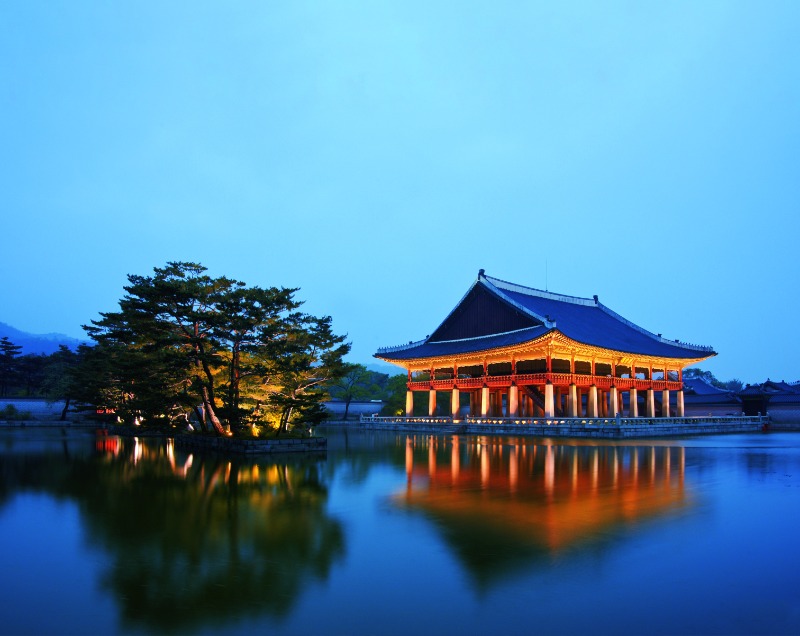
The Gyeonghoeru Pavilion in Gyeongbok Palace was where the kings dined with their officials and received envoys. Fire destroyed the original pavilion. The rebuilt version was completed in 1867. It has circular inner pillars and wide, square-shaped outer pillars, in accordance with the traditional belief that the sky is round and the earth is square.
© gettyimagesKOREA
Just past the threshold of any ancient Korean palace is a stone arch bridge that spans an artificial stream called Geumcheon. The name literally means “forbidden stream.” Its clear water flows between a palace’s front and inner gates, a nod to the principles of ancient geomancy, or pungsu. It was believed that a home with mountains in the rear and water in the front would ward off evil spirits and ensure an auspicious future. The stream also functioned as a reminder to visitors that they should wash away their worldly ways and behave with dignity inside the palace.
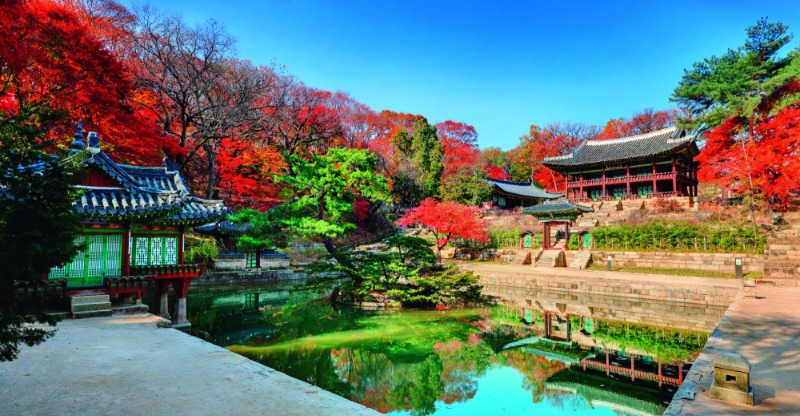
Towering above the northern end of Buyong Pond in Changdeok Palace’s Secret Garden is Juhamnu, a two-storied pavilion that King Jeongjo (r. 1776–1800) used as a place to study and unwind.
© Korea Cultural Heritage Administration
The scenic area around a palace’s Geumcheon hints at what awaits farther inside. Auspicious animals are sculpted along the bridge, and a variety of trees provide shade and color. Plum, cherry, and apricot trees burst with bright hues in the spring and bear fruit after the summer.
The central part of a palace is where the king and his officials conducted state affairs and received visitors. This area is austere. There is nothing eye-catching except for the mountain looming behind.
Unique Design
The palace gardens of the Joseon Dynasty embody the landscaping ideals of the time, their beauty rooted in the simplicity of their design and their respect for nature. Ponds are rectangular and flower beds adhere to the terrain, blending into the natural landscape. Thus, when compared to well-known traditional gardens elsewhere in East Asia, one might say Joseon palace gardens lack distinctive features. They are not easily identified at a glance like the private gardens in Suzhou, China, where oddly shaped rocks set against white walls resemble miniature natural landscapes, or the gardens of Kyoto, Japan, where sand and stones are used to represent water and mountains.
The defining feature of traditional Korean palace gardens lies in their inexactness. Traditional Korean gardens do not aim to reproduce a natural landscape in miniature. They are interpretations rather than representations. The essence is not nature as it appears on the surface, but the ethical principles hidden within it. If the function of gardening as a form of art lies in expanding the mind, the Korean art of gardening is about rediscovering nature in its original state through minimal intervention.
Perfect Harmony
The oldest traditional palace garden is found in the heart of Seoul at Gyeongbok Palace; it is relatively well-preserved. Installed in 1412 by King Taejong (r. 1400–1418), it is deemed to be the quintessential Joseon-era garden. Situated on a vast, flat area west of the royal sleeping quarters, it includes a rectangular pond and surrounds Gyeonghoeru, an immense pavilion situated inside the pond. These components combine to project impressive geometrical beauty.
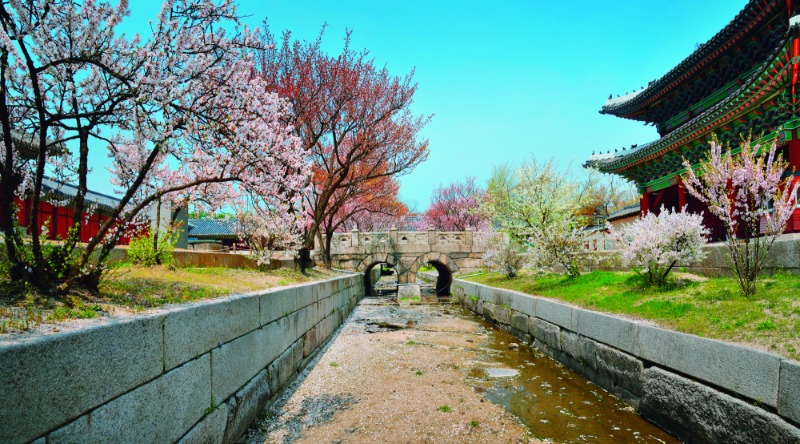
The Okcheon Bridge is the first space one encounters upon entering Changgyeong Palace. Serving as a gateway into the royal compound, it is meant to remind visitors to behave with dignity inside the palace.
© Korea Cultural Heritage Administration
The pavilion is the largest structure of its kind of the Joseon Dynasty. It offers a view of Mt. Bugak, the “guardian mountain” just behind the palace, and of the tiled, curved roofs of the palace buildings that give the illusion of undulating waves. Standing atop the towering pavilion, the Joseon rulers would have been reminded of their duties to the land stretching out beneath them.
Regional government offices and aristocrats took note. The Gyeongbok Palace garden remained a template for hundreds of years, influencing the style and aesthetics of government and private gardens throughout the land.
Nearby, the rear garden of Changdeok Palace offers natural elegance thanks to its hilly topography. Along with the palace’s residential and office buildings, the garden constitutes a perfect harmony of architectural, landscaping, and natural beauty.
The construction of the garden at the back of the palace compound began in the 17th century. The work was slow and deliberate, gradually incorporating the natural elements. Besides the hills, the site features gullies, streams, trees, rocks, and springs.
Upon stepping into the Changdeok Palace garden, the first space awaiting visitors is the area surrounding Juhamnu, a pavilion nestled above on hilly terrain. From below, the multi-storied structure can be admired in all its splendor, and from atop, it offers views of the pond below. A long staircase connects the pavilion to the pond. Meanwhile, the Jondeokjeong pavilion area features a pond that is irregular in shape and several other pavilions of varying forms built right on the edge of the water.
In the area surrounding Ongnyucheon, a stream in the innermost part of the garden, wide rocks were carved tothe landscape, and many small pavilions were built as places to sit and quietly enjoy the scenery. The forest where these pavilions are found is breathtaking. With its young leaves and pretty flowers in spring, welcome shade in the summer, colorful foliage in autumn, and snow-covered solitude in winter, the forest is arresting all year round.
Respect for Nature
Joseon’s royal palaces also have smaller gardens dispersed throughout the grounds, adjacent to living spaces. Prime examples of this are Amisan behind Gyotaejeon, the queen’s living quarters at Gyeongbok Palace, as well as the garden behind Daejojeon, the queen’s living quarters at Changdeok Palace. Both gardens consist of terraced flower beds. They contained a variety of flowers and other plants which changed with the seasons, as well as elaborately adorned chimneys and ornamental rocks.
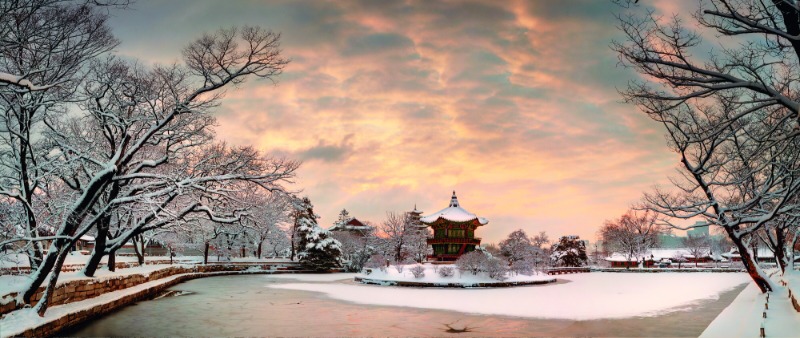
The hexagon-shaped Hyangwonjeong Pavilion served as a resting place for the king and the royal family. Its construction, believed to have taken place in the latter half of the 19th century, included the traditional Korean underfloor heating system (ondol), but it was not discovered until recently, during restoration work.
© Korea Cultural Heritage Administration
Other examples would include the glorious gardens of Geoncheong Palace, a separate royal residence inside Gyeongbok Palace, and Nakseonjae, a residential compound inside Changdeok Palace. Since Geoncheong Palace mainly served as a place for the king and queen to relax, the area around it includes a garden and a large pond with an islet and a two-story, hexagonal pavilion in its center. Anyone crossing the bridge to reach the pavilion in summer wouldinstantly understand what inspired its name; Hyangwonjeong means “pavilion amidst the far�reaching scent of lotus blossoms.” The garden surrounding Nakseonjae at Changdeok Palace isequally famous for its beauty. A staircase going up the terraced flower beds leads visitors to a pavilion with an unencumbered view of the surroundings and Manwolmun, the gate so named for its full-moon shape.
Transformation and New Role
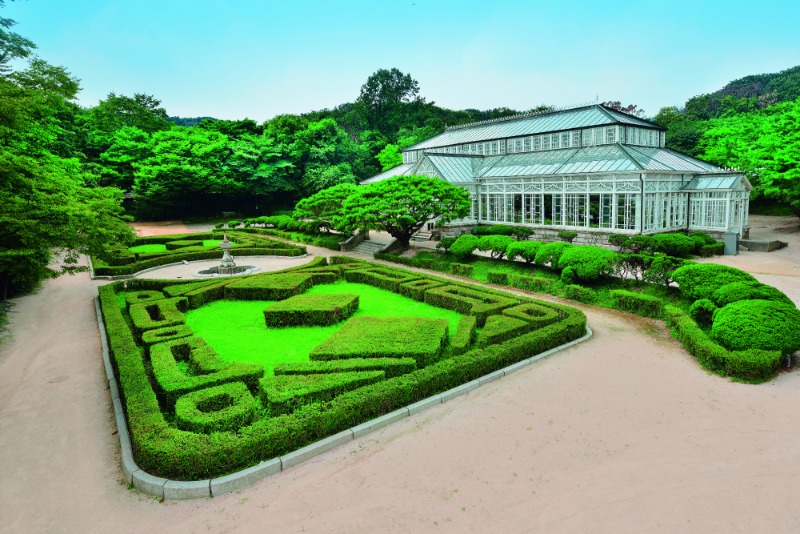
The Grand Greenhouse of Changgyeong Palace, built in 1909, was the first Western-style building of its kind in Korea. It became a popular attraction due to its many tropical plants and other flora not common to Korea.
© Korea Cultural Heritage Administration
After the fall of the Joseon Dynasty, its palaces were turned into public parks and the traditional approach to landscaping underwent a major transformation.
Changgyeong Palace in Seoul received an early makeover. During the dynastic period, an open space deep inside the palace was used for archery practice and horseback riding. The king also used part of the area to raise crops himself. In 1909, the Grand Greenhouse was built in that open area. Made of steel and glass, the Western-style greenhouse was the first structure of its kind in Korea. A parterre garden fronted it, and in 1911 a pond was installed as a further complement. It was circular rather than rectangular like traditional Joseon ponds.
Today, palace gardens continue to display the beauty and inherent philosophy of traditional Korean landscaping. Once strictly reserved for the enjoyment of the royal family, they have become recreation grounds for the public and sightseeing attractions for tourists. Some parts remain largely intact, offering a glimpse into the past, and it is easy to imagine the royal family’s enjoyment of the palace flora, forests, ponds, and pavilions.